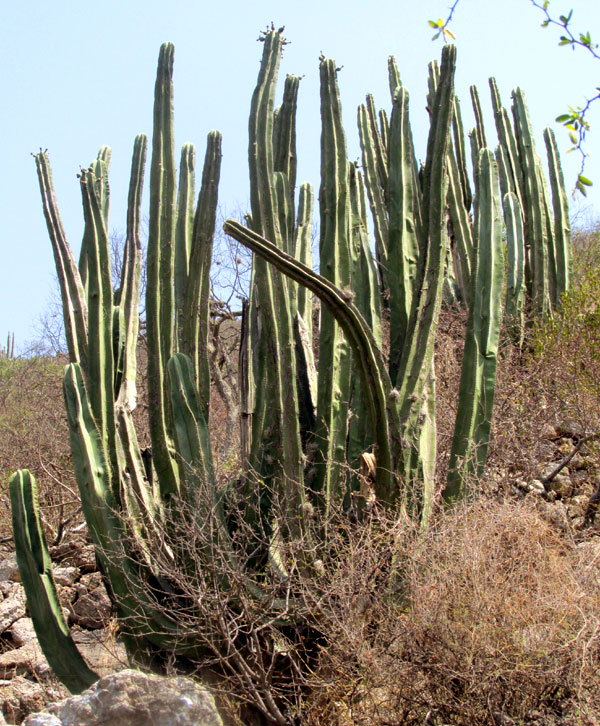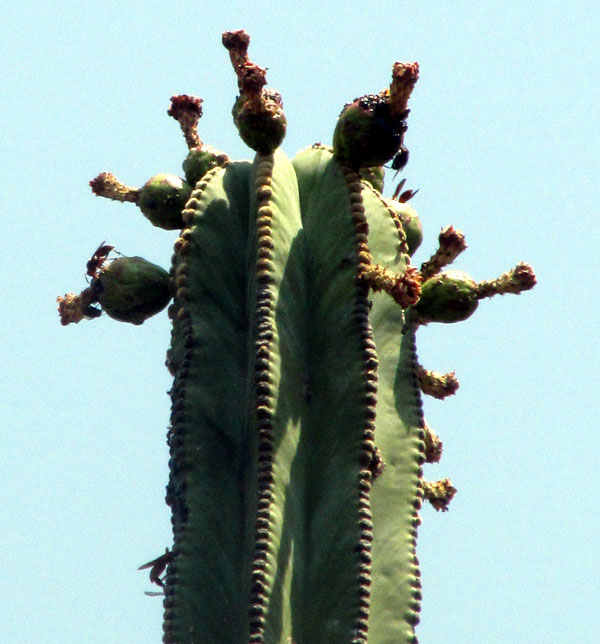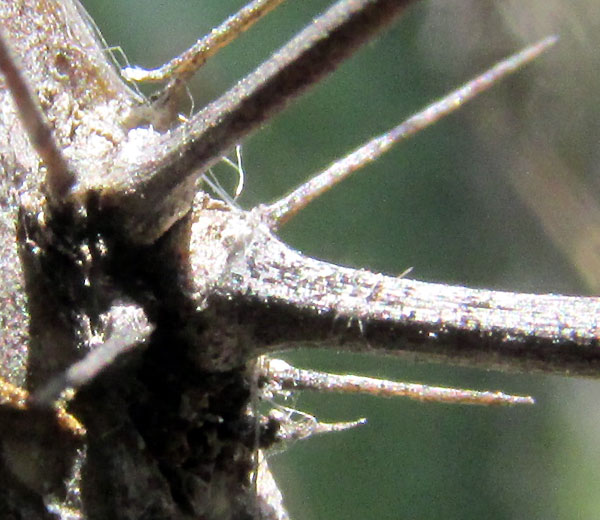Excerpts from Jim Conrad's
Naturalist Newsletter
entry dated May 21, 2022, issued from near Tequisquiapan, elevation about 2040m (6700 ft), Querétaro state, MÉXICO On a rocky, south-facing slope in the valley just east of La Higuera, about 7kms ENE of Tequisquiapan, among boulders mostly composed of the pinkish, extrusive volcanic rock rhyolite, the handsome cactus shown above hovered above my tent one night. It stood about 5m tall (15ft). Knowing that it was in the area, I'd been looking for this species, hoping it'd be flowering. Without the flowers I might have trouble distinguishing it from other tall, columnar species also found here. Happily, this one was flowering, as seen below: The size of the flowers and their fast-enlarging ovaries -- the future fruits -- can be gauged by noticing the wasps and fly attracted to the ovaries. Actually, this picture shows two important field marks for recognizing the species. Notice how, along the crest of each vertical ridge, the bumps touch one another above and below. The bumps are areoles, the special spots on cacti where spines arise. Among all but one of this region's tall, columnar cacti with such ridges, only two species have their areoles touching. And one of the species, the famous Mexican Fencepost Cactus, arranges its smaller, much more numerous blossoms all along the ribs, from lower down to the top, not all clustered toward each stem's top, as shown above. So already we know which species this is, but for good measure it's still worth checking out the spines. Below, a close-up shows how the stems' rib crests bristle with intermingling spines of different lengths: The gray pompom-like thing at the upper right is a Ballmoss, not a moss at all but a bromeliad epiphyte as much at home perched on cacti as tree branches and telephone wires. In this species 7-12 spines of different lengths arise from each areole. The center ones are longer than those surrounding them. Notice how the areoles fuse together at their ends. Above is an even closer look at the spine bases, mostly just for the fun of it, to admire the surreal architecture of "up close." So, in English this is usually called the Candelabra Cactus, though other species with this general form share that name.
CANDELABRA CACTUS FLOWERING





Unlike its cousin the Fencepost Cactus, this species doesn't take to cultivation. Still, some folks like its sweet, fleshy fruits enough to go looking for them, knocking them down with poles. Álvaro Munguía-Vázquez and others in their 2018 publication entitled "Uso y conocimiento de cactáceas en la comunidad otomí de El Alberto, en Ixmiquilpan (Hidalgo, México)" reports that among the Otomí of upland central Mexico, not only the fruits are eaten but also the flowers have been used as sweeteners. Traditionally the Otomí used the cactus medicinally at least in three ways, plus for "esthetic hair care," "el cuidado estético del cabello," which I suspect to be the Mexican academic's high-flying manner of expressing that they stuck this species' flowers in their hair, to make themselves pretty. The flowers are yellow maybe sometimes reddish, which must look fine in the Otomís' black, glossy hair.